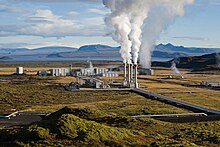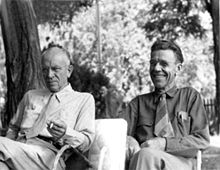User:MathStudent24/sandbox
Article Draft[edit]
Minor Edits (5 each)[edit]


- Add picture for logging and mining
- Add picture for geothermal energy
- Add citation on "More than 109 million acres designated as wilderness"
- (4-6) Add citations in "Notable associates of the Wilderness Society" (Celia Hunter, Mardy Muriem Sigurd Olson)
The organization was instrumental in the passage of the 1964 Wilderness Act.[1] The Wilderness Act led to the creation of the National Wilderness Preservation System, which protects 109 million acres of U.S. public wildlands. [2]
Notable associates of The Wilderness Society[edit]
- Olaus Murie — biologist who joined the organization's governing council in 1937, and became president of the Society in 1950. Under Murie's leadership, the Society lobbied successfully for the prevention of large federal dam projects near Glacier National Park and Dinosaur National Monument. During his presidency, the Muries' ranch in Moose, Wyoming, became an unofficial headquarters for The Wilderness Society.[3]
- Sigurd Olson — author and former president and governing council member[4]
- Celia Hunter — founder of the Alaska Conservation Society and the first woman elected as president of the Society in 1976; previously served on the governing council[5]
- Howard Zahniser — author of The Wilderness Act of 1964 — joined The Wilderness Society in 1945, serving for two decades, first as executive secretary and editor of the organization's magazine The Living Wilderness; later he served as the organization's executive director.

- Mardy Murie — conservationist and Alaska advocate, former governing council member. Known as the "grandmother of the conservation movement," Mardy Murie was instrumental in the designating of the Alaska National Wildlife Refuge as a protected wilderness area, and documented much of her experiences in nature, often alongside her husband Olaus, in her books, including Two in the Far North. In 1964, Mardy Murie attended the signing of the Wilderness Act by then President Lyndon Johnson.[5]
- Gaylord Nelson — former US Senator from Wisconsin and founder of Earth Day — served as counselor to The Wilderness Society
- Wallace Stegner — author of fiction set in the West, former governing council member
- Ansel Adams — photographer and conservationist, former governing council member
- Deanna Archuleta — former southwest regional director of The Wilderness Society, former Deputy Assistant Secretary for Water and Science at the Department of Interior[6]
- Stewart M. Brandborg — executive director from 1964 to 1976 during which time more than 70 wilderness areas in 31 states were brought under the Wilderness Act's protection.[7]
- Ernie Dickerman — focused on preserving wilderness in the eastern United States, The Wilderness Society staff from 1956 to 1976, Virginia Wilderness Committee president from 1976 to 1979, "Grandfather of Eastern Wilderness."
Major Edits (2 each)[edit]
(Wilderness Act)
In The Wilderness Act, Zahniser defines the word wilderness as “an area where the earth and its community of life are untrammeled by man, where man himself is a visitor who does not remain." [8] This word choice is important because it implies that the areas deemed wilderness would be "unconfined, uncontrolled, unrestrained, or unmanipulated [by humans]." [8] By clearly defining the word, The Wilderness Act provided a guideline for how to determine what exactly wilderness is and how it is to be treated. Maybe controversially, under this definition, the Wilderness Act permits natural disasters, like forest fires, to ensue naturally. Only in the event that the fire is going to spread out of the boundary of the wilderness, then the act allows it to be controlled. [8] This idea of letting nature take its course also includes prohibiting beneficial manipulation of the wilderness, such as restocking a lake full of a struggling fish species. [8] This again is a direct implication of how the word wilderness was defined.
(Goals)
The Wilderness Society has worked with the United States Forest Service (USFS) to come up with goals on the issue of public land production:
"(1) To obtain as much wilderness value as possible relative to the cost and value of the foregone opportunities to produce other goods and services for society. (2) To disperse the future wilderness system as widely as possible over the United States. (3) To represent as many ecosystems as possible so that the scientific and educational purposes of wilderness preservation are best served. (4) To obtain the most wilderness value with the least relative impact on the nation's wood production output. (5) To locate some new wilderness areas closer to densely populated areas so that more people can directly enjoy their benefits." [9]
These goals and their complexity demonstrate the progress that has been made in just over half a century of the Wilderness Society. In 1964, there were 9 million acres of federal wild land, but now the Wilderness Society has such lofty goals and much more extensive wilderness areas, demonstrating its success over the years. [9]
References[edit]
- ^ "Howard Zahniser: Author of the Wilderness Act". Wilderness.net. University of Montana. Retrieved 9 February 2015.
- ^ National Park Service. "Wilderness - Death Valley National Park (U.S. National Park Service)". www.nps.gov. Retrieved 2024-03-25.
- ^ "Olaus Murie". Wilderness Society. Retrieved 16 July 2014.
- ^ "Our History | The Wilderness Society". www.wilderness.org. Retrieved 2024-03-25.
- ^ a b "11 women who made wilderness history | The Wilderness Society". www.wilderness.org. Retrieved 2024-03-25.
- ^ "Secretary Salazar Appoints Deanna Archuleta Deputy Assistant Secretary for Water and Science". 10 April 2009.
- ^ "Stewart Brandborg, longtime leader of Wilderness Society, dies at 93". Washington Post. April 18, 2018. Retrieved March 15, 2019.
- ^ a b c d Proescholdt, Kevin (2008). "Untrammeled Wilderness". Minnesota History. 61 (3): 114–123. ISSN 0026-5497 – via JSTOR.
- ^ a b Luke, Timothy W. (December 1999). "The wilderness society: Environmentalism as environationalism". Capitalism Nature Socialism. 10 (4): 1–35. doi:10.1080/10455759909358884. ISSN 1045-5752.
 | This is a user sandbox of MathStudent24. You can use it for testing or practicing edits. This is not the sandbox where you should draft your assigned article for a dashboard.wikiedu.org course. To find the right sandbox for your assignment, visit your Dashboard course page and follow the Sandbox Draft link for your assigned article in the My Articles section. |
